This post may contain affiliate links. For more information, please see our affiliate policy.
Onions are a crucial building block of flavor in many recipes, but also a dreaded task for some. Learn How to Cut an Onion so you can slice, dice, and julienne like a master. Suddenly, everything in the kitchen feels easier.
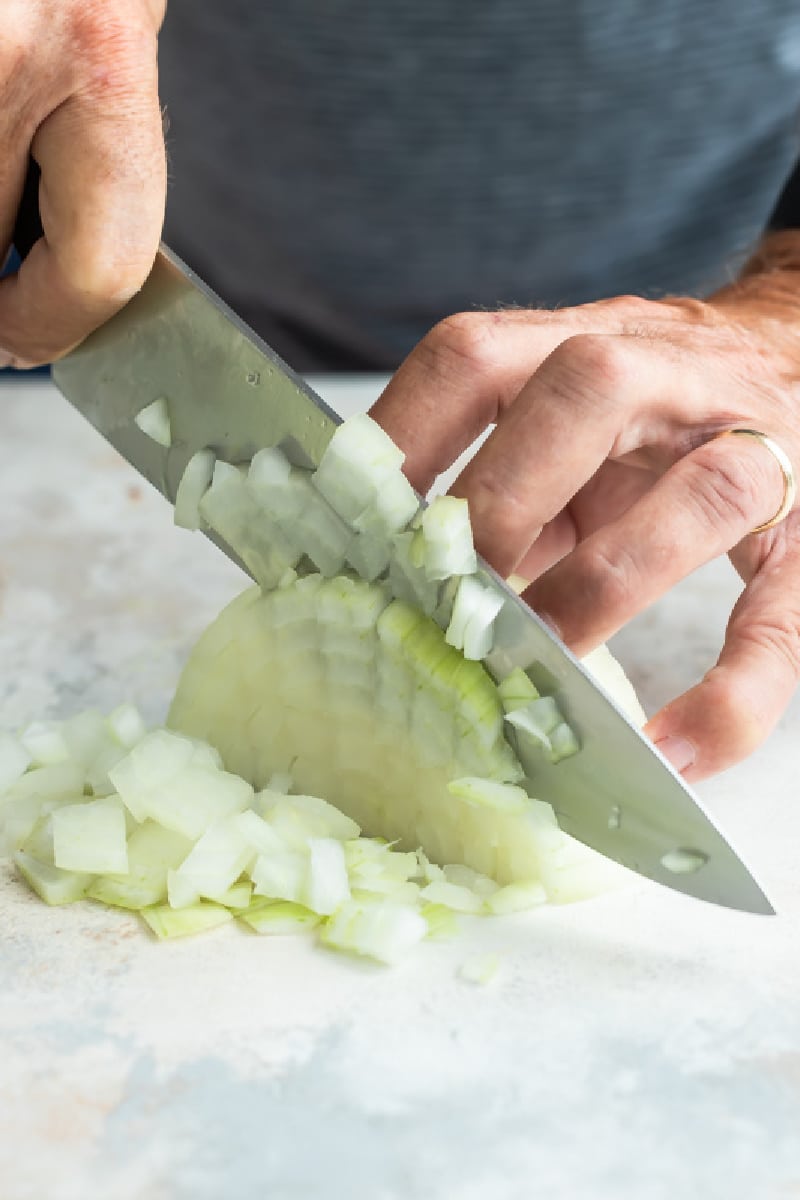
Learning to cut an onion is like riding a bike: Once you know, you never forget. And while cutting onions can be a dreaded task, it doesn’t have to be!
Great technique ensures you’re done as soon as possible. At best, you’re off and running in the kitchen that much sooner. At worst, you’ll be shedding fewer tears. Whatever the situation, everything about cooking feels lighter when you are comfortable cutting onions.
Table of Contents
Recipe ingredients
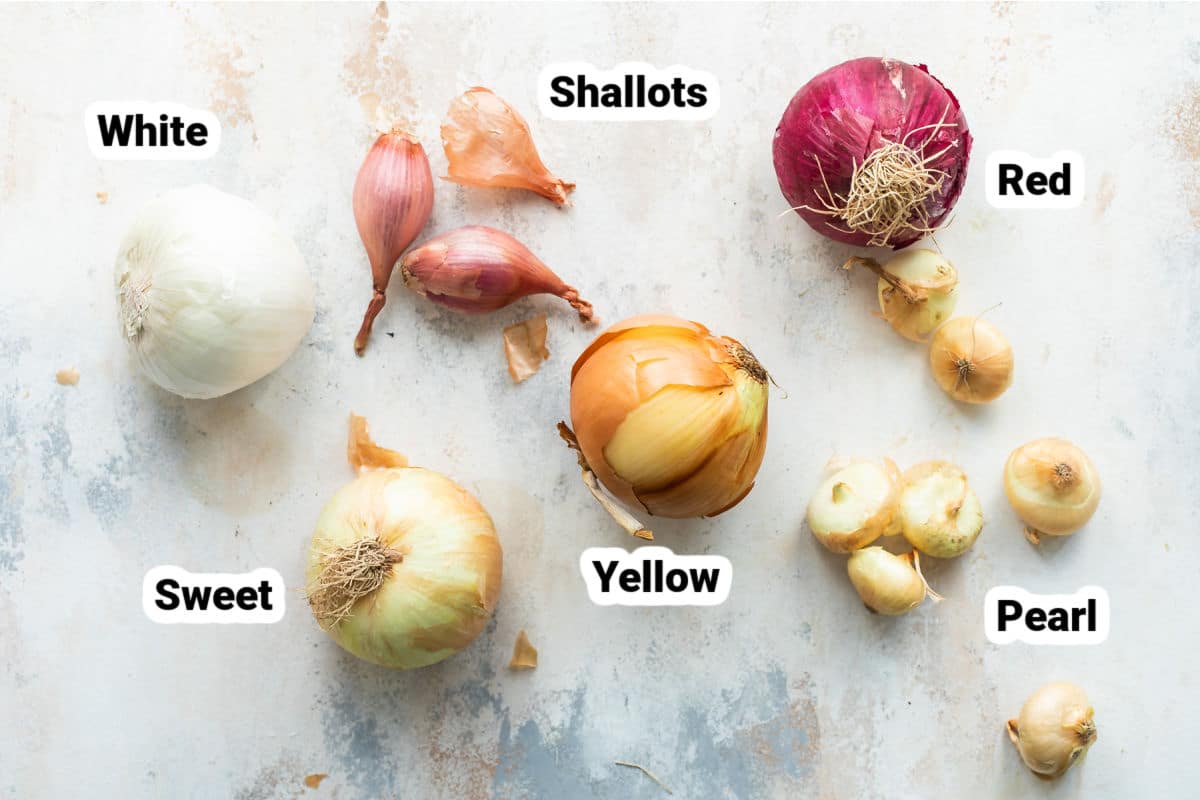
At a Glance: Here is a quick snapshot of what ingredients are in this recipe.
Please see the recipe card below for specific quantities.
Ingredient notes
- Types of onions: An onion is technically a bulb because it grows underground with its root intact. These tips for how to cut onions will work on any of the varieties below.
- Yellow onions: Versatile and widely available, yellow onions have layers of white flesh and a tough, brown-yellow skin. They’re spicy and astringent, but they sweeten up beautifully when cooked.
- Sweet onions: Also known as Walla Walla or Vidalia, sweet onions are often battered for onion rings and fried onion recipes. They’re higher in sugar than yellow onions and are mildly sweet in flavor.
- White onions: White onions are often large with white-fleshed and thin paper-like skin. Mostly used in Mexican cuisine, they are crunchy and on the sharper side.
- Red onions: Light purple-colored red onions are ideal to eat raw in salads or work well pickled or grilled.
- Shallots: These small, clustered onions have pinkish-brown skin and white or light pink flesh. Milder and more delicate in flavor than most other onions, shallots are great to use when you’re planning to eat them raw. They offer a hint of garlic flavor, too.
- Pearl onions: These tiny onions can be red, white, or yellow in color and have a mild, sweet flavor. They are ideal for pickling, creaming, or adding to stews such as Beef Bourguignon.
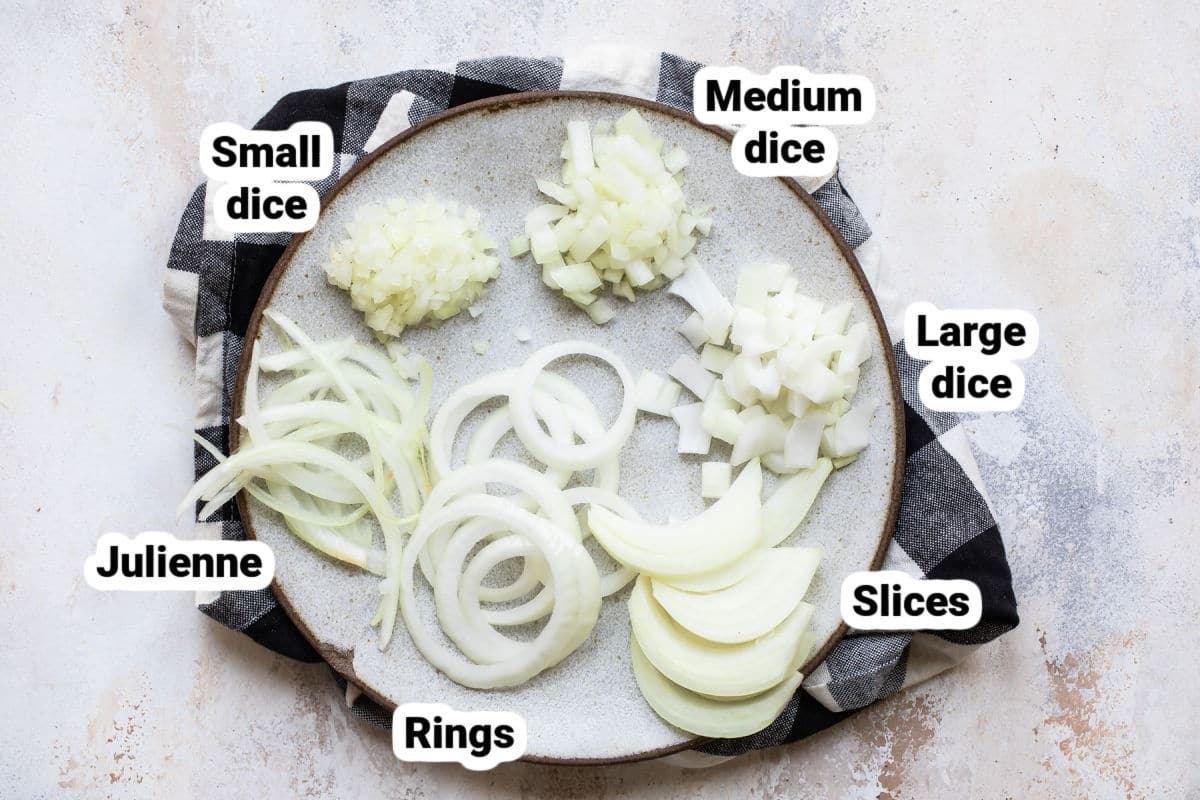
Step-by-step instructions
To peel an onion:
- Using a very sharp knife, cut a thin slice away from the root and stem of the onion, but leaving the root intact.
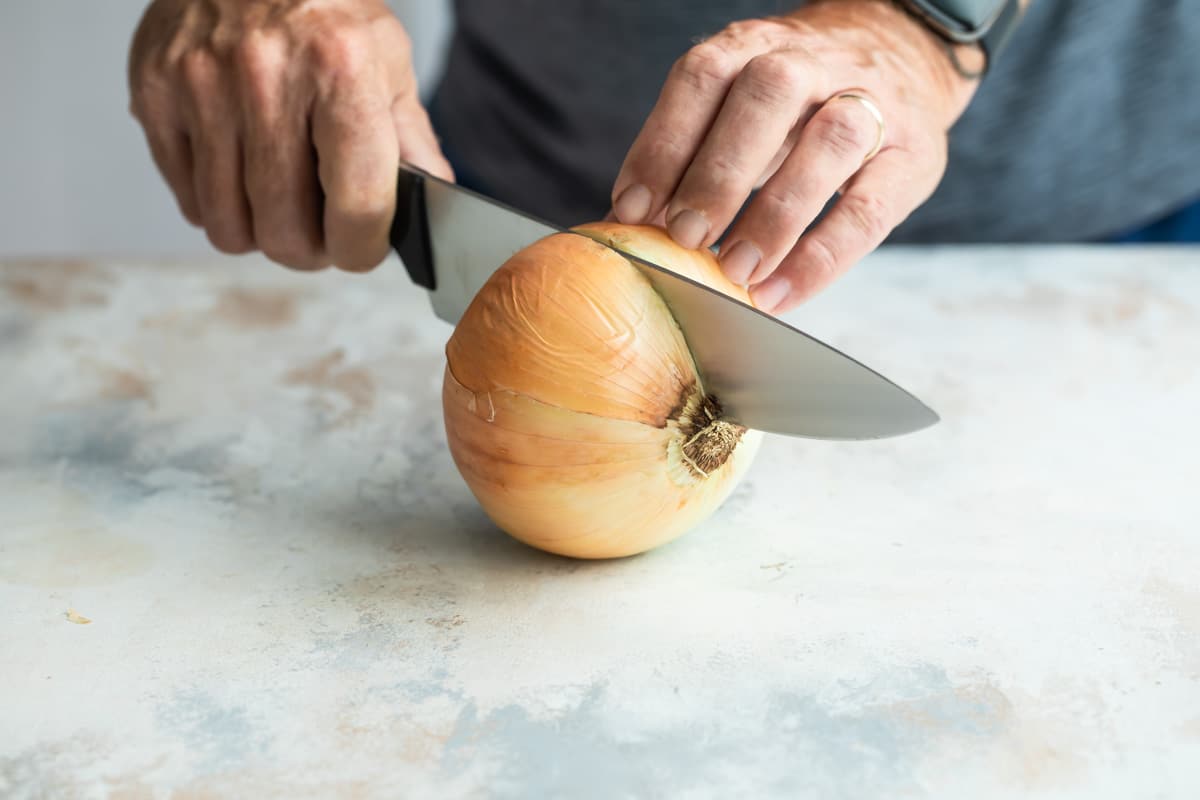
- Place the onion half stem-side down on the cutting board and slice in half from the root end to the stem end. Gently peel away the outer layer and using the tip of the knife, remove any dark spots.
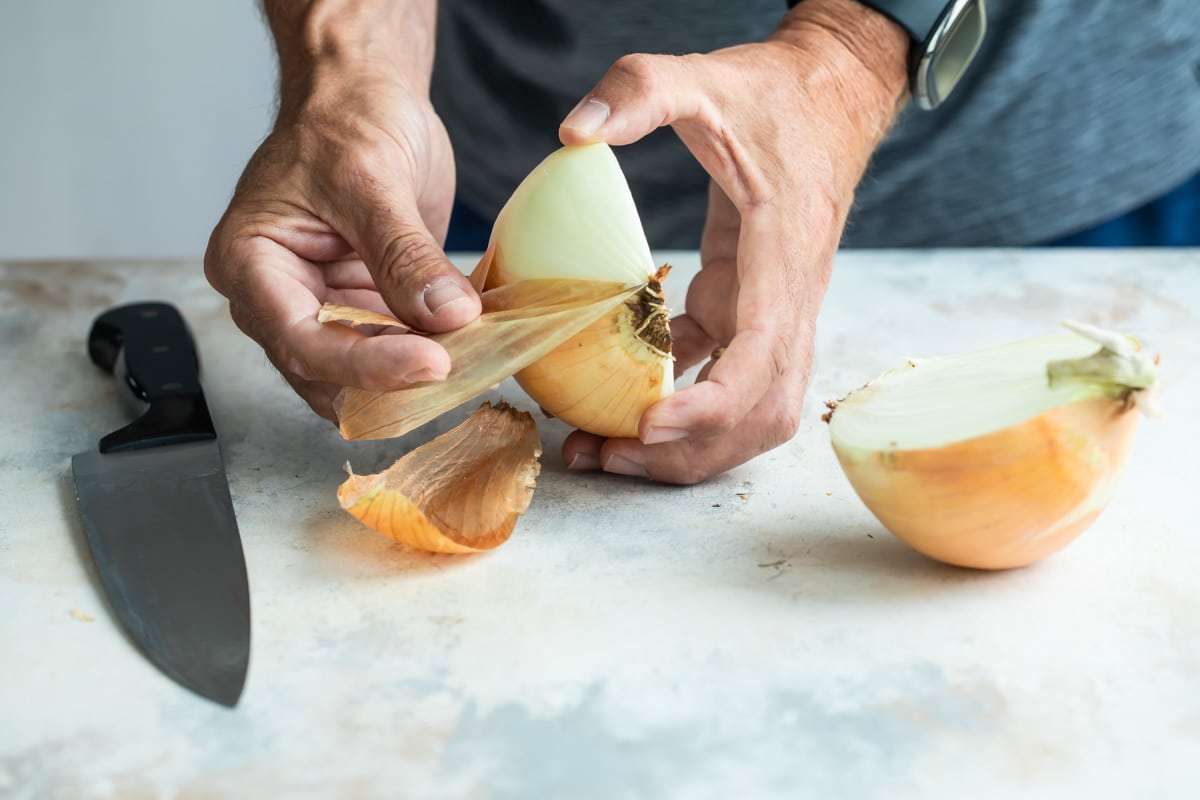
To dice an onion:
- Lay the onion flat side down onto the cutting board. With your non-dominant hand pressing down on the top of the onion, using a sharp chef’s knife, make two to three horizontal cuts (parallel to the cutting board) into the onion, cutting to just before the root end. The root end will hold the onion together.
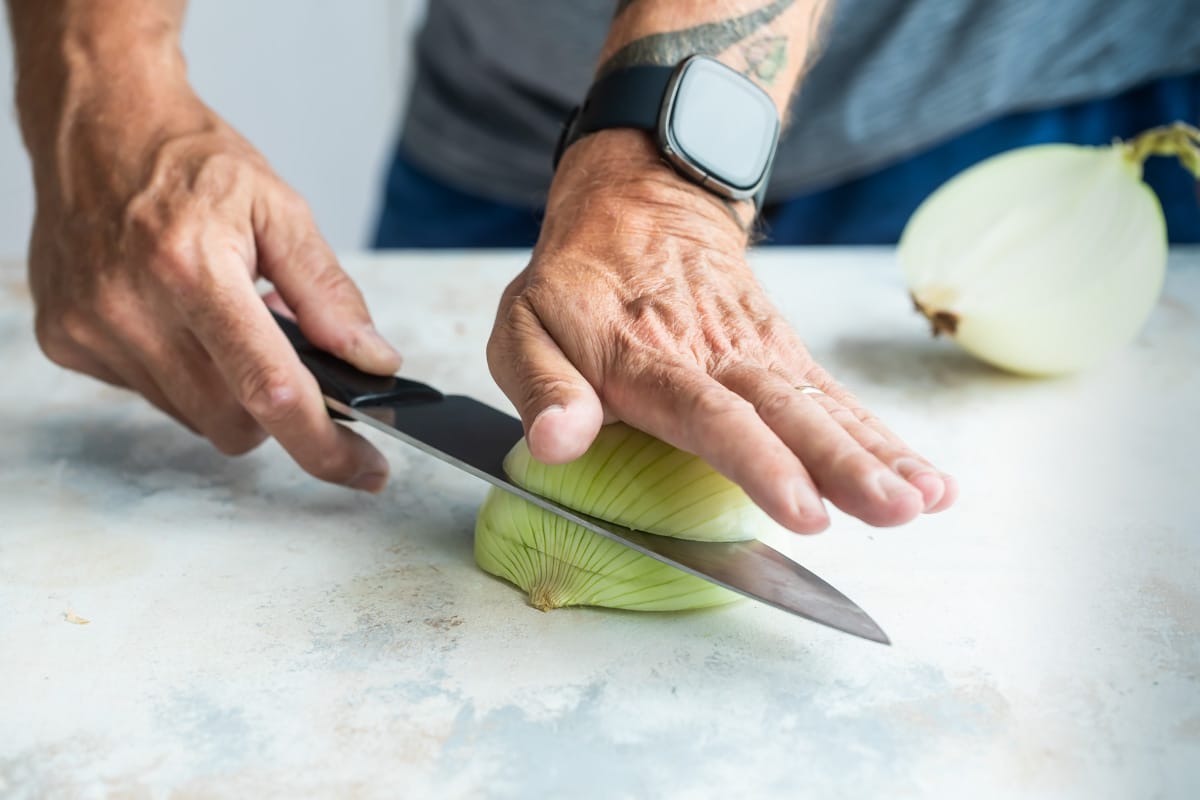
- Next, make a series of evenly spaced parallel, lengthwise cuts with the tip of the blade.
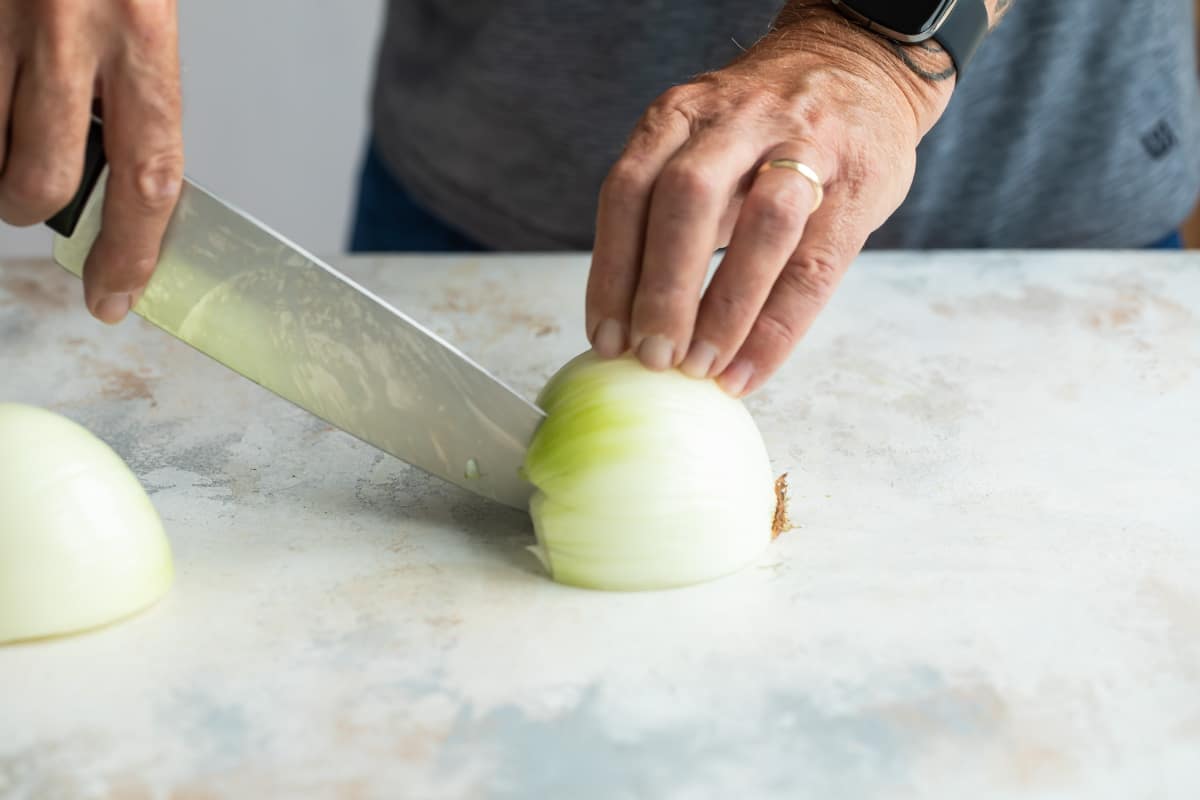
- Last, holding the onion in your guiding (non-dominant) hand with your knuckles curved into a claw shape, complete the dice by cutting even vertical cuts (crosswise), working from the stem end to the root end of the onion. Be sure to cut through all layers of the onion and avoid your fingertips.
- Cuts spaced 1/4-inch apart will make small dice
- Cuts spaced ½ inch apart will make medium dice
- Cuts spaced ¾ inch apart will make large dice
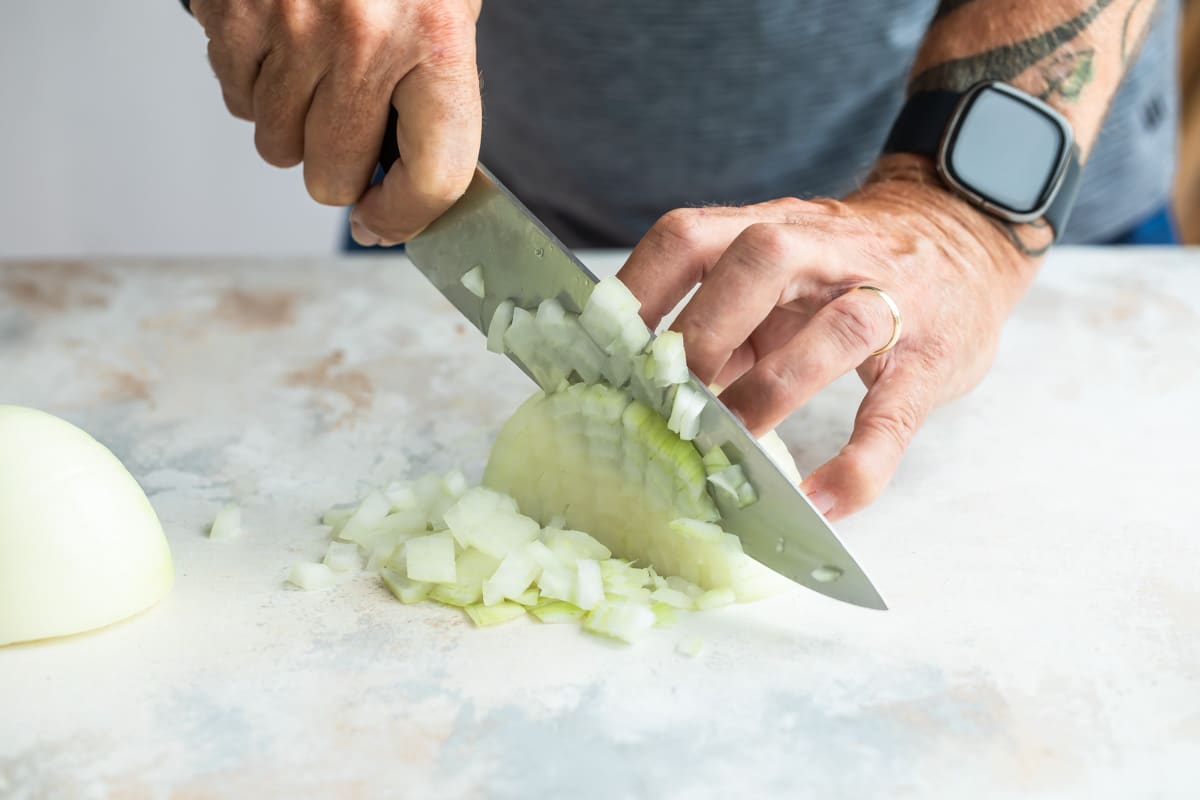
To julienne an onion:
- Lay onions with cut sides down on the cutting board. Remove the root end. With the root end or the stem end facing you, make evenly cut matchstick-sized cuts through the onion, moving in a radial fashion towards the center of the onion, changing the angle with each cut.
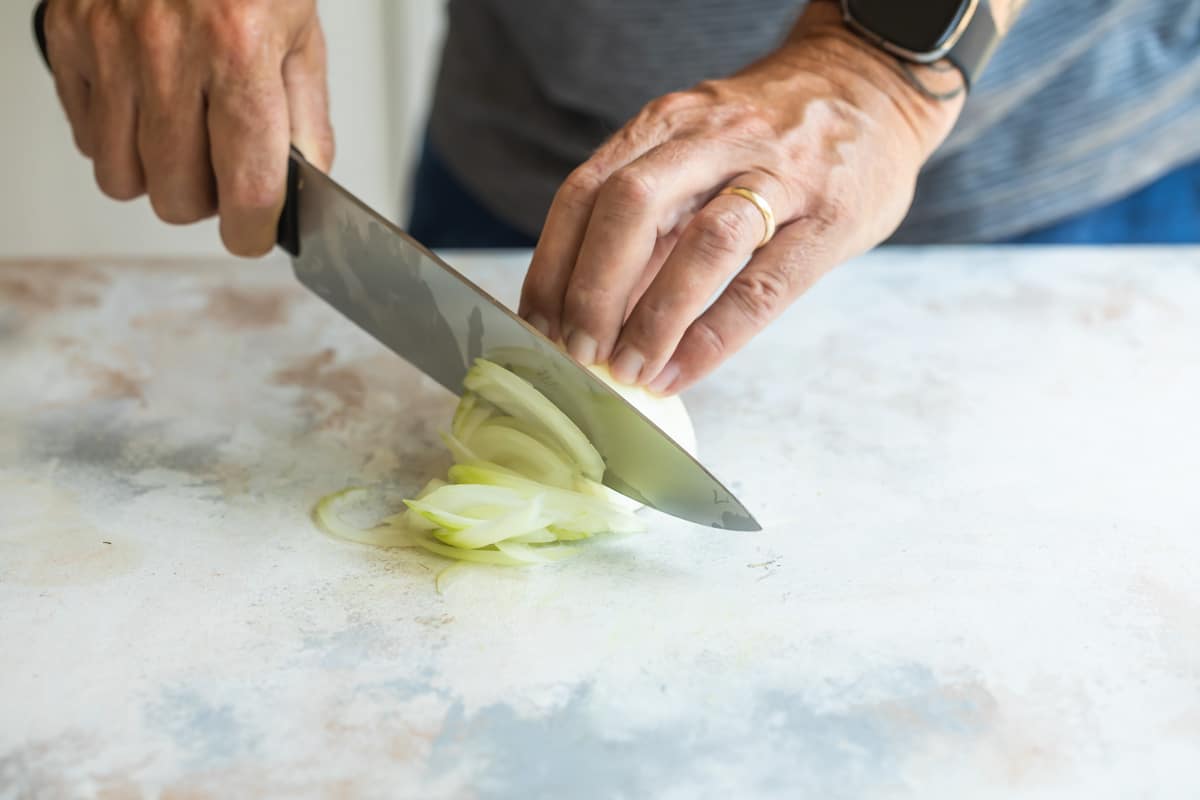
To slice an onion:
- Lay the onion cut-side-down onto the cutting board. Using a sharp knife, make a series of cuts, slicing them to the desired thickness.
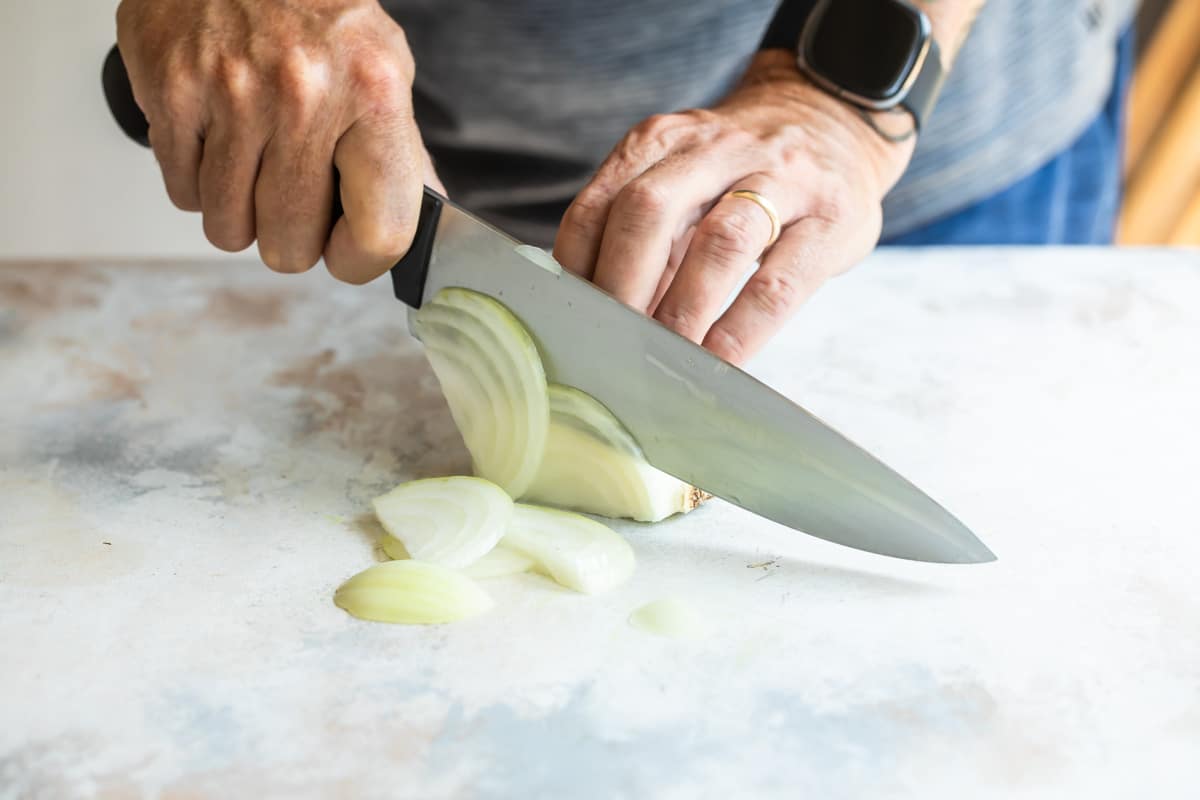
To slice onion rings:
- Do not slice the onion in half as directed in step 2. Holding the onion firmly with your guiding hand, slice into the onion starting at the stem end into rings of the desired size, stopping just before the root end. Discard the root end and break up the onion slices into rings.
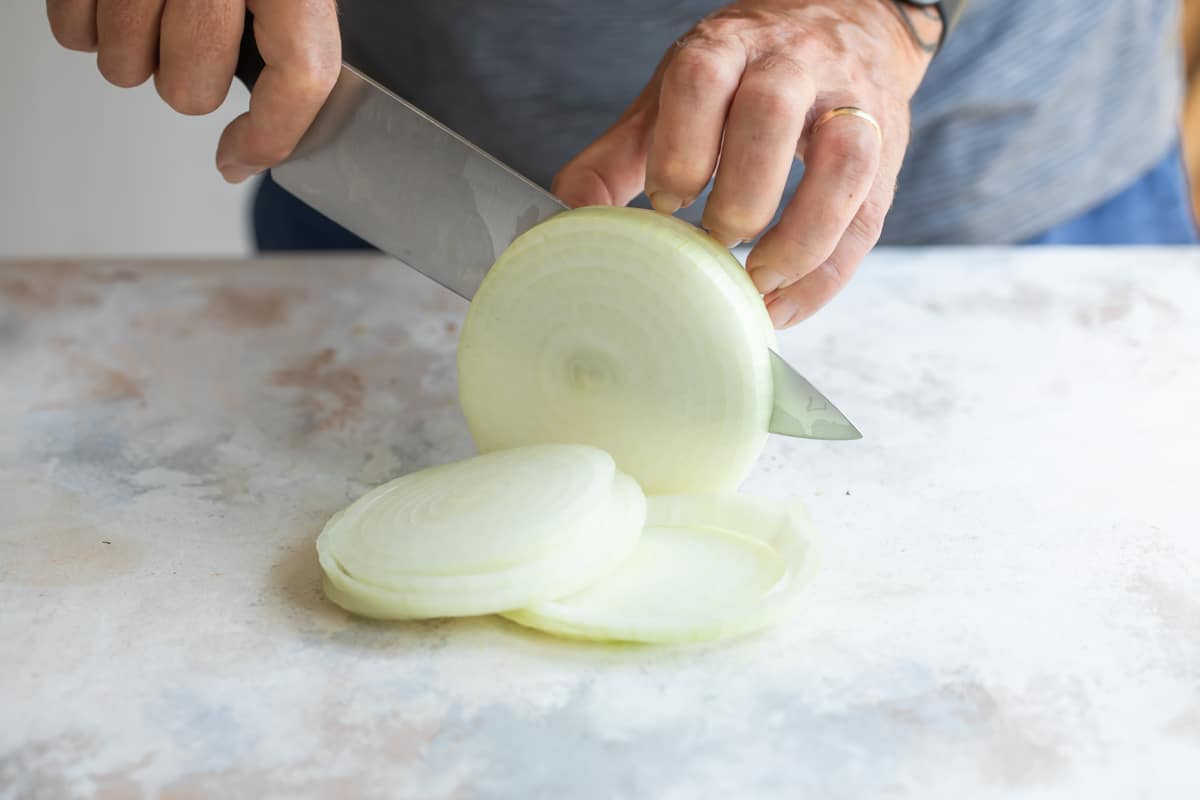
Recipe tips and variations
- Yield: 1 pound of onions yields about 4 cups sliced or diced raw onions. This cooks down to about 2 cups of cooked onions.
- Storage: Whole onions and shallots last for about 2 to 3 months when stored in a cool, dry, dark, and well-ventilated place such as a basement or the bottom of your pantry. Refrigerate peeled whole onions and shallots in an airtight container for up 10 to 14 days. Cut onions should be stored in the fridge and used within 7 to 10 days.
- Freezer: Chopped, diced, sliced, and mince onions can all be frozen. Transfer to freezer-safe containers, wrap in plastic wrap, label, date, and freeze for up to 3 months. Add to soups, stews, and sauces directly from the freezer (no need to thaw).
- Make ahead: Onions that are served raw or play a starring role in your dish, even when cooked, are best cut right before using them. However, if they are being layered with other flavors in a more complex dish, they can be cut up to 4 days in advance.
- Buying: Choose onions that are firm to the touch and free from soft spots, blemishes, and brown spots.
- Uniform size: While there are many options for how to slice onions, no matter which way you choose, aim for uniform pieces so they cook evenly (if applicable) and look orderly.
- Soaking in water: When onions are cut, they release a pungent enzyme called isoalliin. To tame the harsh smell and flavor of isoalliin, soak cut onions in water.
- Using onions: Onions appear in thousands of recipes across all cuisines. Some of my favorite ways to use them include caramelized onions on burgers, as a vegetable in stir-fries, skewered with kebabs, layered on a sandwich, or added to soups, sauces, salsas, and salads.
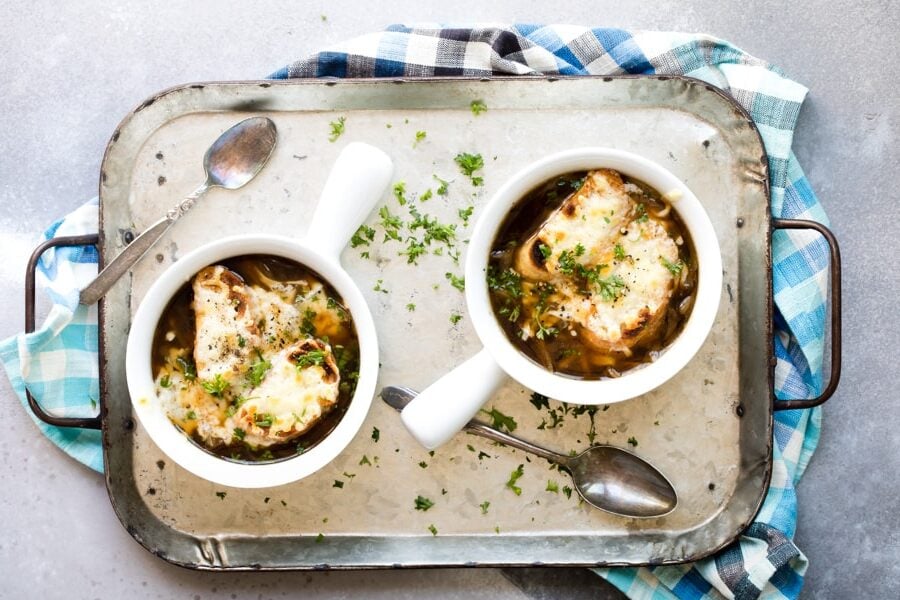
Frequently Asked Questions
Yes, peeling an onion is a necessary prep step before cutting them. To peel an onion, using a sharp knife, cut a thin slice away from the root and stem of the onion, but leaving the root intact. Place the onion stem-side down on the cutting board and slice in half from the root end to the stem end. Gently peel away the outer layer and using the tip of the knife, remove any dark spots.
There are many ways to cut onions, including small, medium, and large dice, sliced, julienned, and rings.
To mellow the harsh flavor of raw onions, soak cut onions in water. This tempers the enzyme isoalliin that is released when onions are cut.
In classical French cooking, there are specific measurements you must follow for small (1/4″), medium (1/2″), and large (3/4″) dices. In culinary school, we used a culinary ruler which has cutouts of the exact sizes and shapes (perfect cubes) that you train for. Chopping, on the other hand, is much more casual and unstructured.
Onions are naturally gifted at absorbing sulfur which they store in their cell walls. These sulfur compounds are released when you slice through onions. I’ve tried onion goggles and in my opinion, they don’t work very well. No matter how much practice you get, it’s always painful to cut an angry onion! Even the pros cry sometimes.
Put your onions to work
Appetizer Recipes
Shrimp Ceviche
Salad Recipes
Chickpea Salad
Salad Recipes
Wedge Salad
Salad Recipes
Watermelon Salad
Join Us
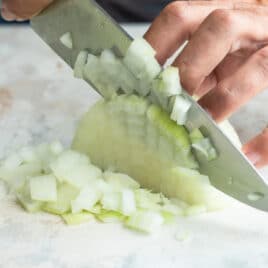
How to Cut an Onion
Ingredients
- 1 onion (about 6 ounces)
Instructions
To peel an onion:
- Using a sharp knife, cut a thin slice away from the root and stem of the onion, but leaving the root intact.
- Place the onion stem-side down on the cutting board and slice in half from the root end to the stem end. Gently peel away the outer layer and using the tip of the knife, remove any dark spots.
To dice an onion:
- Lay the onion cut-side-down onto the cutting board. Using a sharp knife, make two to three horizontal cuts (parallel to the cutting board) into the onion, cutting to just before the root end. The root end will hold the onion together.
- Next make a series of evenly spaced parallel, lengthwise cuts with the tip of the knife.
- Lastly, holding the onion in your guiding hand (non-dominant), complete the dice by cutting even crosswise cuts working from the stem end to the root end of the onion. Be sure to cut through all layers of the onion.
To julienne an onion:
- Lay the onion cut-side-down onto the cutting board. Remove the root end. With the root end or the stem end facing you, make evenly cut matchstick-sized cuts through the onion, moving in a radial fashion towards the center of the onion, changing the angle with each cut.
To slice an onion:
- Lay the onion cut-side-down onto the cutting board. Using a sharp knife, make a series of cuts, slicing them to the desired thickness.
To slice onion rings:
- Do not slice the onion in half as directed in step 2. Holding the onion firmly with your guiding hand, slice into the onion starting at the stem end into rings of the desired size, stopping just before the root end. Discard the root end and break up the onion slices into rings.
Notes
- Yield: 1 pound of onions yields about 4 cups sliced or diced raw onions. This cooks down to about 2 cups of cooked onions.
- Storage: Whole onions and shallots last for about 2 to 3 months when stored in a cool, dry, dark, and well-ventilated place such as a basement or the bottom of your pantry. Refrigerate peeled whole onions and shallots in an airtight container for up 10 to 14 days. Cut onions should be refrigerated and used within 7 to 10 days.
Nutrition
Meggan Hill is a classically-trained chef and professional writer. Her meticulously-tested recipes and detailed tutorials bring confidence and success to home cooks everywhere. Meggan has been featured on NPR, HuffPost, FoxNews, LA Times, and more.

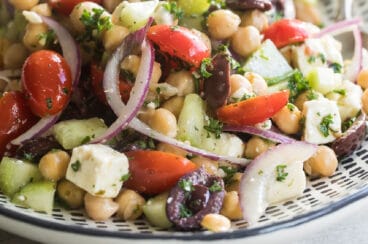
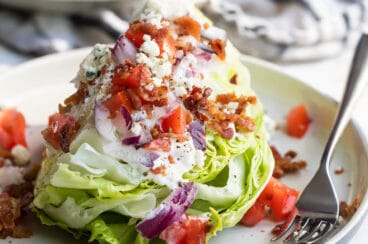
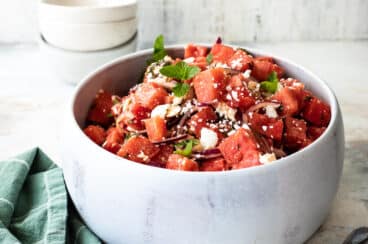
YAY!!! Thank you. I never pursued a different approach, but the usual way gave me good reason to buy a pair of Kevlar gloves for my holding hand. LOL
Happy Holidays!!!
I know this is what is taught in every culinary school and is always seen on TV food shows, but it is not the best way to cut an onion.
It requires three cuts while the way I do it only requires two cuts using the natural divisions of the layers of the onion as the third cut.
It is also faster as you are not having to be careful to leave the root intact.
Cut the ends off.
Cut the onion in half from end to end.
Lay it flat on the cutting board.
Slice, however thick or thin you want, starting at the root or other end and moving towards the other cut end.
Now, keep in mind we are cutting a curved object.
Place your knife almost parallel to the cutting board and cut from the outer edge to wards the center.
Continue this cutting, again, as big or small as you like, but moving your knife more and more vertical to the cutting board so that when you are cutting the middle, your knife is now perpendicular to the cutting board.
Continue cutting, laying your knife more parallel to the cutting board again so at the end, your knife is almost flat again.
You can dice very fine or large. You can slice only. You can cut just a 1/4 of the onion (for this you lay the sliced flat on the board and making the same radius cuts, make the second cut.
I have to say, I did see someone on Iron Chef use this method. It is faster, easier, and safer.
I am so happy that I came across this method of cutting an onion. Using this method is extremely efficient, and makes it look like I actually know what I’m doing. I will never go back to my old method of cutting an onion ever again… as that was basically hacking at it with a knife and trying not to cry as I spent way to much time getting it all diced small enough.
Happy to help Steven! – Meggan